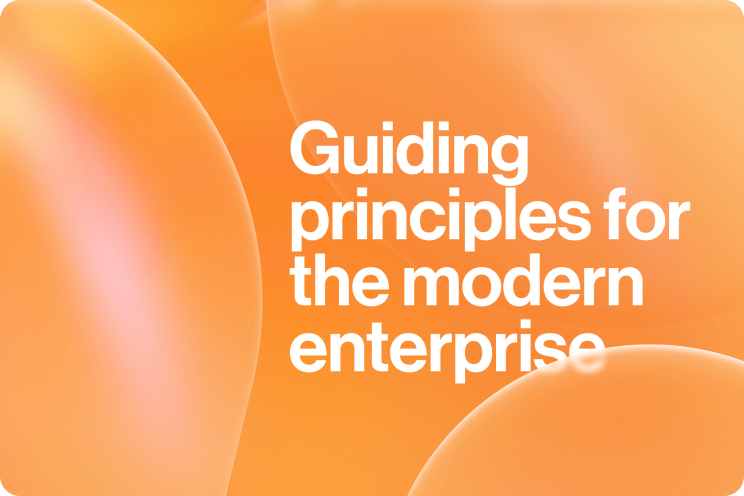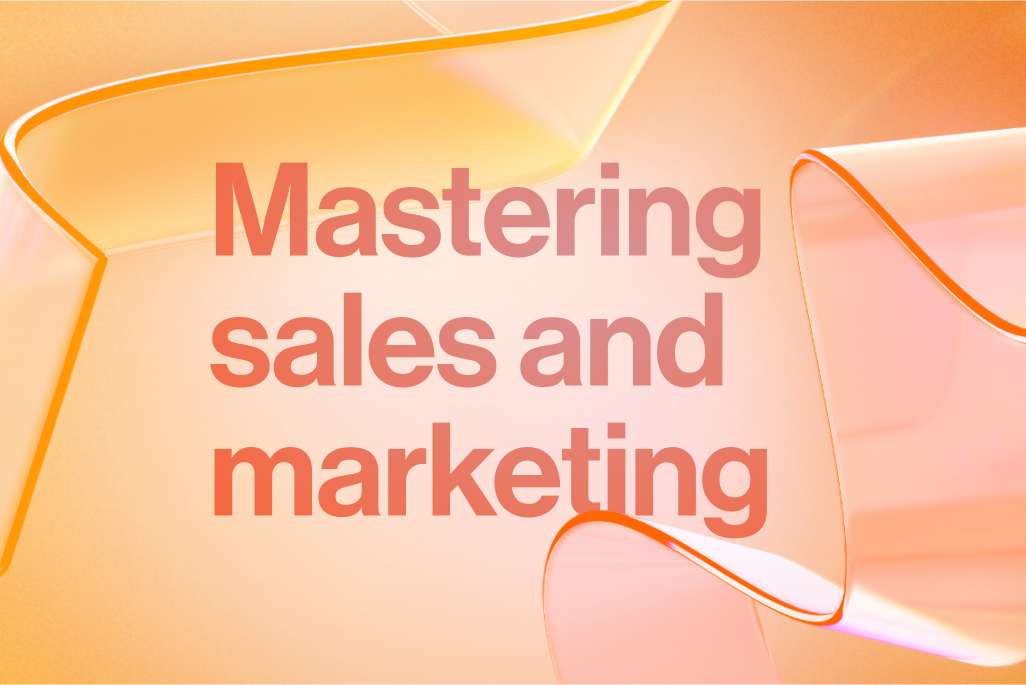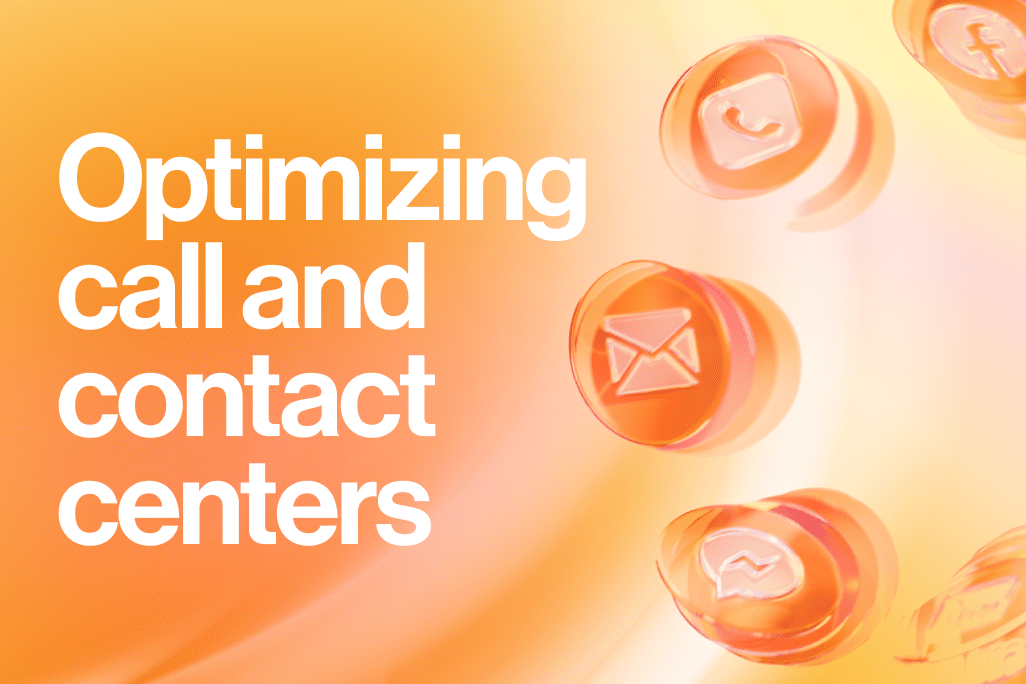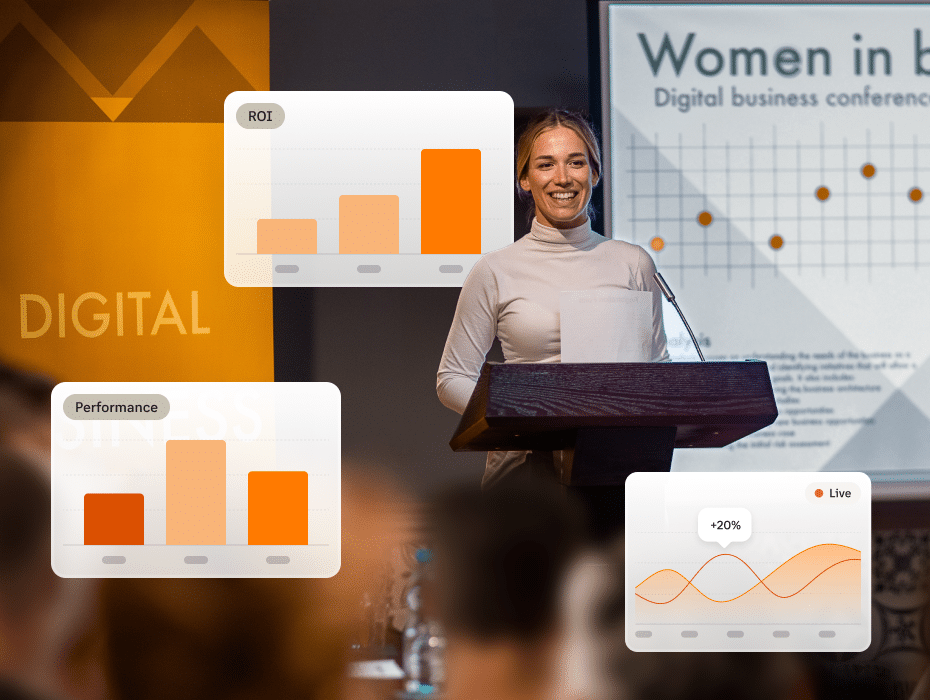Unless you’re a wayfinder –– someone who navigates the seas using nothing but nature and stories –– you likely travel with a destination and a plan in mind. Otherwise, you end up wandering aimlessly.
While there’s some level of uncertainty with just about everything in life, having a plan can set you up for success with many things — including events. Setting goals for your event and outlining the actions it will take to reach those goals can help you:
- Establish what success looks like for your team
- Predict where elements will fall into place and where they might go awry
- Understand what numbers you need to hit to be profitable or break even
- Easily communicate your event needs within your organization
First, let’s establish a common language. Despite being distinctly different, the terms “goal” and “objective” are often used interchangeably. Understanding the definitions will help you properly frame your action plan:
- A goal is a broad, long-term outcome. It’s where you want to go.
- An objective is a measurable action to take in service of the long-term goal. It’s a step you take to get where you want to go.
Now that we’ve laid a foundation, let’s work on nailing down your event goals and objectives. Whether you’re starting from scratch or need a refresher, this definitive guide provides a step-by-step walkthrough for setting clear event goals and objectives.
Step #1: Ask yourself the hard questions
Want to set solid goals and objectives? Start by getting to know every inch of your event.
When evaluating your event, it’s important to get thorough answers to fundamental questions like:
- Why is your organization hosting this event in the first place?
- Who is your audience?
- Why will audience members feel compelled to show up?
- What will they expect to learn by the end of your event?
- Who are the key stakeholders that stand to benefit from your event?
- What is it about your event that’s important to your stakeholders?
- Who is on your event team and what are their responsibilities?
- How will you measure success?
Your detailed answers will help provide a clear picture of where you want to end up once your experience has wrapped.
To fully understand your event and why it exists, you’ll need to dig deep on internal priorities, but you’ll also want to compare your event to other external experiences.
Step #2: Do internal and external research
If it’s your first time planning an event, don’t skip this critical part of the process. Researching the current landscape around your event topic can help you shape your goals and objectives –– and ultimately design a gathering that stands out from the others. Take a look at:
- Your organization’s internal priorities: Consider how you’ll align the event with your organization’s mission, upcoming initiatives, any changes, and new product launches.
- The competitive landscape for similar events: Browse event calendars for past and future events to gather insights on goals for other experiences, how other event organizers are attracting attendees as well as common pitfalls to avoid. Don’t forget to take note of similar events scheduled for the same time period to determine if competitors might be targeting similar goals and how you can best serve your audience.
- The sponsorship environment: Attracting and signing a sponsor can make or break your event so it needs to factor into your goals and objectives. Understanding what activations other event planners are creating with their sponsors can also help lay the foundation for your event sponsorship proposal.
- Speakers who will support your goals: If you have a specific speaker in mind, you can reach out to them directly or indirectly through a contact. Another option is to create a “call for speakers” where you invite speakers to apply to talk at your event. In either case, you’ll want to research potential speakers (including their past speaking engagements) to figure out how they can support your goals and start thinking about who might be the right fit.
- Themes, topics, and ideas: How are other event organizers tapping into event themes, topics, and ideas to meet their goals? Not only can engaging themes attract potential attendees, they can also entice people to attend the entire event versus dropping off. Start thinking of useful topics and ideas that align with your attendees’ interests and pain points as well as your organization’s priorities.
- Event formats and locations: Consider what format makes sense for your event community –– virtual, hybrid, or in-person –– and how that will influence the goals and objectives you set.
Once you’ve done some homework and understand the landscape you’re working with, you’re ready to define your event goals and objectives.
Step #3: Use a goal-setting framework for guidance
At this point, you’ve completed the necessary steps to determine the goals that make sense for your event. But it’s important to recognize not all goals are created equal — some are “smarter” than others.
When setting event goals, use the S.M.A.R.T. framework which helps its users create goals that are specific, measurable, achievable, relevant, and time-bound.
Why do so many people drop their New Year’s resolutions after a couple of months (or weeks)? It’s usually because they:
- Didn’t have a game plan.
- Didn’t set milestones.
- Weren’t realistic.
- Didn’t focus on what fit their lifestyles.
- Didn’t give themselves the right amount of time, or they procrastinated.
Being more purposeful and thoughtful about the details surrounding a goal makes it more likely you’ll achieve the desired outcome. The S.M.A.R.T. system can help with that. Here’s an example of how a generic goal and a S.M.A.R.T. goal differ:
- Generic goal: We hope for more turnout and more email signups than last year.
- S.M.A.R.T. goal: We’re aiming for a 75% event turnout, and in turn, a 7% increase in email marketing signups by the end of the quarter.
To create a truly smart goal, avoid generic, sweeping statements that offer little insight into the desired outcomes of your event. Let’s review all the elements of a S.M.A.R.T. goal.
S: Specific
A specific goal narrows down the type of success an event organizer seeks.
Let’s go back to our travel analogy: Imagine having a goal of visiting Thailand. While that is a goal, it doesn’t go into detail about whether you’ll travel solo or with other people, your specific destination, why you’re going, what you’ll do while you’re there, and how you’ll get there. Lack of structure makes the goal less likely to happen.
Now, let’s explore what this looks like in the world of events:
- Non-specific goal: I would like this to be a thought leadership conference.
- Specific goal: I’d like to boost our thought leadership by securing five leading experts in our field to speak and be associated with our brand, thus attracting a 20% larger audience than last year.
Where a broad goal leaves room for interpretation on whether or not the goal was met, a specific one allows you to clearly define what was achieved –– and what wasn’t.
M: Measurable
A measurable goal typically relates to how you’ll evaluate the goal in a quantitative way. Some of the measurable outcomes of an event are:
- Registrations
- Revenue generated
- Number of attendees
- Total sponsor leaders
- Event Net Promoter Score (NPS)
- Average time spent at your event
- Overall return on investment
Take a look at these two examples and guess which one is more effective:
- Unmeasurable goal: We need revenue from sponsorship dollars.
- Measurable goal: We need 7% of revenue to be generated by sponsorship dollars.
A measurable goal matters throughout the event lifecycle as it can be tracked and quantified. From there, setting future goals often gets easier as you can benchmark against previous results.
A: Achievable
Once a goal can be measured, you’ll be able to define what will indicate the goal has been achieved. While you want to be ambitious, it’s also important not to let your goals get too outlandish –– to the point where you have no real way to achieve them. Event goals that stray from realistic business goals may not be taken seriously, which results in less buy-in from your team.
Here’s why research makes all the difference when setting your goal:
- Unachievable goal: We want 100% turnout.
- Achievable goal: The average turnout per virtual event in the past has been 74%, so we’re aiming for 80% turnout this year.
Setting an unachievable goal and thus failing to meet it will leave stakeholders with the impression that your event was a failure and jeopardizes the chances of hosting follow-up events. Taking more of an “underpromise and overdeliver”-type approach is more likely to turn stakeholders into loyal partners long term.
R: Relevant
Would you pack a winter coat for a trip to Thailand? Not if you did your research. Research provides insight into what’s relevant to your audience and internal stakeholders.
Can you spot the misstep in this goal?
- Irrelevant goal: For our product launch, we want to see how many t-shirts were sold.
- Relevant goal: For our product launch, we want 45% of audience traffic to flow through our new product booth by the end of each day.
In this example, the number of t-shirts sold doesn’t necessarily make a large impact on what stakeholders would want to see in this case, which is exposure to a new product.
Goals that aren’t relevant to those they serve tend to be overlooked. And if goals are ignored, what was the point of setting them in the first place? Be sure to understand how your outcomes will make an impact on the teams that matter within your organization.
T: Time-bound
Your goal is taking shape: It’s specific, measurable, achievable, and relevant. But when is the right time to start and finish measuring success?
Setting a time-bound goal means that the goal is aligned with a specific timeframe so anyone reviewing it or acting upon it knows the deadline.
- Not a time-bound goal: We would like more social media followers.
- Time-bound goal: By the end of each conference day, we want a 4% increase in social media followers across all platforms.
Timeframes are critical because they keep your team accountable. Your team will understand the confines of the event goals and how to develop objectives that will help them meet those goals on time.
Step #4: Develop objectives your team can rally around
Now that you have a S.M.A.R.T. goal, you’ll need to create a roadmap for reaching that goal and provide examples of key measurements to track throughout your event lifecycle. Prepare to collaborate, as this step requires strategizing with your team and key stakeholders.
Take this hypothetical scenario: Let’s say the S.M.A.R.T. goal is to increase ticket revenue by 10% from last year’s event. From this goal, you might partner with key stakeholders to develop the following objectives that will hopefully lead to the 10% increase in ticket revenue.
Sample revenue objective
In order to drive more revenue from ticket sales, you’ll need to consider increasing the ticket price and the event’s perceived value. After research and discussion, you might decide to pursue the following objective:
- Secure top speakers and talent to attract a higher volume of attendees
You conclude that a well-known and respected thought leader within the industry will attract attention, which would result in increased ticket sales.
Sample planning and procurement objective
When it comes to planning and procurement, you might then consider how to entice high-end speakers to present at the conference. But you wonder: How will this be possible with a limited budget?
After research and number crunching, you decide you’ll need some financial assistance. So, your immediate objective is to help reach that 10% increase in ticket sales by:
- Attracting more sponsors to help fund the event
This objective is a win-win-win solution: The team will be able to tap a thought leader to speak and sponsors will have the opportunity to engage with the large event community. The third winner is the audience, who will find value from the speaker and discover new sponsorship offers.
Sample sponsorship objectives
Now that it’s clear sponsors are needed, the team needs to develop a plan around how to attract and retain the best sponsors. At this point, they create more actionable objectives:
- Determine the value of your event
- Understand your data
- Understand the sponsorship landscape
- Determine who is best to reach out to
- Determine when is best to reach out
Thus begins the sponsorship procurement quest as they set out to find sponsors who share values with their organization and will eagerly invest to connect with the event’s target audience.
Sample marketing objectives
Marketing efforts then need to widen the net for ticket sales. The following objectives could help make it happen:
- Offer a virtual component for the event
- Develop a strategic social media campaign that resonates with the target audience
- Market ticket sales to new demographic groups
- Improve the perceived value of the event
Each objective is intended to expand the event promotion audience. For example, adding a virtual event element will allow for greater accessibility (and, therefore, more reach) and developing a relevant social media campaign will help drive an emotional connection with the audience.
Sample design objective
Folks need to get a feeling of what the event will be like before they’ve even entered. If the look and feel gets them excited, registration is likely to increase. The objective here might be to:
- Use a branding guide to design an enticing landing page for the virtual, hybrid, or in-person event
A compelling landing page, created with user experience in mind, simplifies the registration process, which can result in a bounce rate reduction and, in turn, increased revenue.
Note that the objectives all work together to achieve the same goal. Organizing objectives around your event from the very beginning saves time and helps you achieve your initial goal.
Step #5: Track progress
After setting event goals and objectives — and executing a memorable event aligned with those goals — you’ll want to reflect on and learn from the results. Accessing and using event data will allow you to track relevant metrics that indicate whether you’ve reached your goals. Select regular points throughout your event planning and execution process to track and report on the progress you’ve made toward achieving your event goals.
Want a little inspiration? Here are some real-world examples of events that set and tracked progress against clear goals and objectives:
NOLAvate Black
Based on metrics from previous years, NOLAvate Black’s goal was to increase the percentage of attendees from the previous year and increase connections between tech recruiters and job seekers within the Black community. Despite obstacles, NOLAvate Black:
- Doubled their annual revenue
- Saw an average conference attendance of 7.5 hours
- Garnered 40,000 unique, post-event impressions on conference content
Learn more about how NOLAvate Black achieved their event goals.
YEA! Impact
YEA! Impact, a social impact agency that offers consulting, marketing, and production services to businesses that want to create social change, turned to RingCentral Events to host their annual flagship Hollywood Climate Summit. This conference aims to bring key players in the entertainment industry together to drive action around climate change.
YEA! Impact’s overall goal was focused on making its conference more accessible by adding a virtual element, while still maintaining the same level of interaction and engagement from previous years.
How did they fare? They achieved:
- 80% attendance rate, from over 20 countries
- 500,000 social media engagements
- An average of 8.5 hours spent per attendee
- 9.2 average NPS score
Learn more about how YEA! Impact achieved their event goals.
European Forum Alpbach
For the first time in its 75-year history, European Forum Alpbach hosted its flagship event virtually through RingCentral Events. They needed to maintain the high-level discussions world leaders were accustomed to experiencing at their in-person international socio-political forum.
With that in mind, their overall goals were to build their community and increase the number of attendees from the prior year. In addition, they wanted to increase the percentage of networking connections among attendees.
They achieved their goals with more than:
- 300 speakers
- 100 countries represented
- 2,000 networking connections
- 4,000 online attendees over the course of the three-week forum
Learn more about how European Forum Alpbach achieved their event goals.
Develop event goals that lead you to success
Just as a clear itinerary and navigation tools provide the roadmap for safe and successful travels, clear goals and objectives pave the way for a successful event.
Once you’ve developed your event goals and objectives, communicate them clearly to key stakeholders –– and keep those stakeholders updated as you track progress along the way. You’ll quickly establish yourself as a valuable member of the team who can run an event that delivers.
Take it a step further (and make your life easier) with the right event technology. Reach out today to learn more about how RingCentral Events can help you establish, track, and achieve your event goals.
Updated Mar 13, 2025











